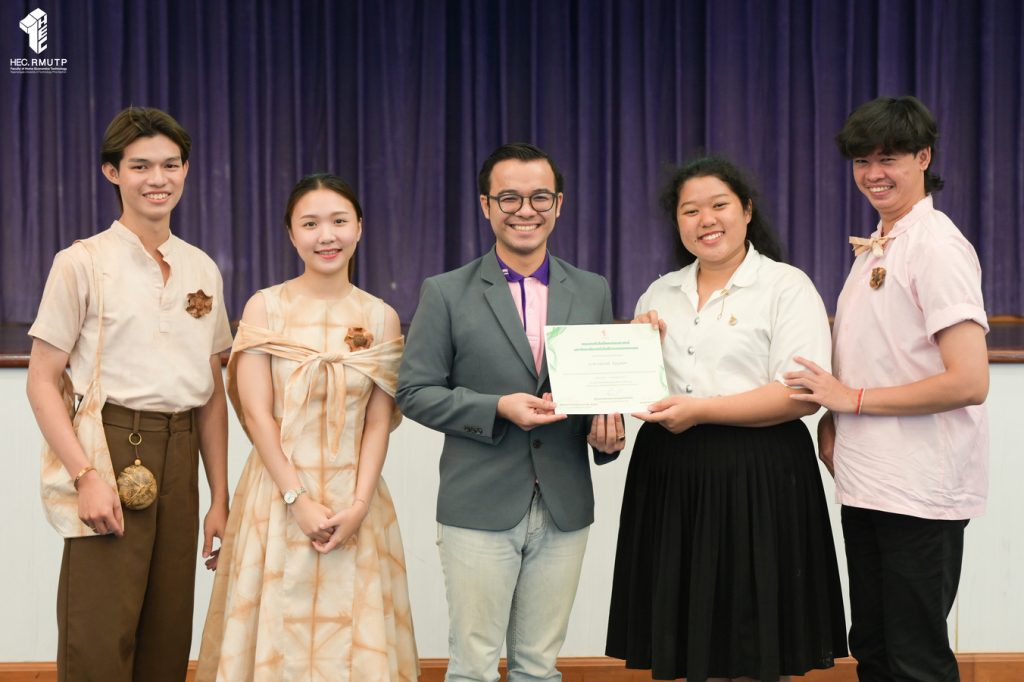Fabric dyeing is an ancient Thai craft, traditionally using natural materials derived from plants, animals, and minerals to add vibrant colors to textiles. This eco-friendly dyeing method has been passed down through generations, becoming a cultural heritage and a unique identity for various communities. Although dyeing technology has evolved over time, natural dyeing remains a simple and sustainable technique. This tradition is preserved in Ban Lom Thuan (also known as Khung Lom Thuan), Samut Songkhram Province, a community known for its ecotourism and local crafts. The residents mainly engage in coconut sugar production and fishing. Additionally, the community has established the Ban Rim Klong Homestay Cooperative, offering tourists activities like coconut leaf hat weaving, traditional dessert making, coconut sugar production, and natural dyeing.
Miss Chulamani Thansamut, a fashion design and fashion product management student at Rajamangala University of Technology Phra Nakhon (RMUTP), was inspired by the large amounts of discarded coconut shells from the local sugar industry. She decided to extract natural dyes from these waste materials to dye fabrics, thereby maximizing the use of local natural resources. This initiative also enhances the community’s identity. Under the guidance of Ms. Mallika Jongjit, a faculty member in fashion design and fashion product management, Chulamani and her team learned that the community had already started extracting dye from coconut husks for use in textile products such as shoulder bags, handbags, coin purses, keychains, and souvenirs. To support tourism and generate income for the community, the faculty integrated the knowledge of natural dyeing into the creation of products and services, aiming to attract more visitors.
Miss Chulamani explained the dye extraction process using coconut shells. Due to the low absorption properties of the chemical components in coconut shells, Taboon bark was added to the process to achieve a more durable color. Taboon bark, which produces tannin, is traditionally used for fabric dyeing. The bark itself is gray or reddish-brown, and when combined with coconut shells, it produces a deep brown hue on cotton fabrics. The process involves boiling equal parts of coconut shells and Taboon bark for an hour, straining the mixture through cheesecloth, and then boiling the extracted dye for another 30 minutes. Sodium silicate (salt) is added to help the dye adhere better to the fabric. The fabric, tied in various patterns, is submerged in the dye bath and stirred continuously for an hour, followed by additional cooling and stirring for half an hour. Finally, the fabric is rinsed in clean water and dried.
Mr. Parada Paksathong noted that in the first wash, most of the dye from the coconut shell and Taboon bark mixture washes out because the pigments do not initially bond with the fibers. However, subsequent washes show no further color loss, indicating that natural dyes from these materials are effective for fabric dyeing. In addition to teaching community members about dyeing techniques, the group also instructed them on adding value to their products by sewing the dyed fabric into items like dresses, headscarves, and small wallets. These products have become a new source of income for the community, making them a distinct feature of Ban Rim Klong Homestay in Samut Sakhon Province. “Our goal is to take overlooked waste materials and turn them into valuable products, creating jobs and income for the community. We are grateful for the guidance from the ‘Royal Initiatives for the Conservation and Development of Products from Plant Genetics’ project by the Faculty of Home Economics Technology, which helped us solve problems and develop high-quality natural-dyed fabrics for the community,” said Mr. Parada.
Ms. Mallika Jongjit, the project advisor and faculty member, emphasized that the 2024 Royal Initiatives project integrates product development and plant utilization into students’ studies. The project encourages students to research and collect data on medicinal plants, transforming them into consumable or usable products. It also promotes the value and sustainable use of local natural resources. Natural dyeing, which can be self-taught and enriched through experience, preserves local wisdom and can be passed on to future generations. By engaging in hands-on projects, students develop a deep respect for conservation and learn about sustainable production methods.

